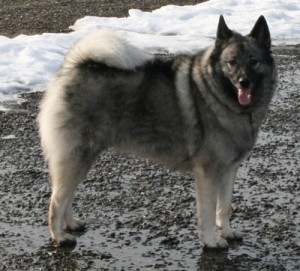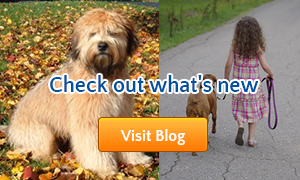 The Norwegian Elkhound, also called the Elkhound or the Norsk Elghund, is a Norwegian breed that was probably developed by the Vikings. They belong to the hound group and they were originally used as watchdogs and guard dogs. They were also used to hunt large game animals like bears and elk. Today this 6000 year old breed is used as a pet.
The Norwegian Elkhound, also called the Elkhound or the Norsk Elghund, is a Norwegian breed that was probably developed by the Vikings. They belong to the hound group and they were originally used as watchdogs and guard dogs. They were also used to hunt large game animals like bears and elk. Today this 6000 year old breed is used as a pet.
The Norwegian Elkhound is a medium sized dog that stands between 19 and 21 inches tall and weighs between 44 and 50 pounds. Their coat sheds year round, but they don’t have the characteristic doggy smell. Their coats should be variegated with gray, white, and black, and they should have black masking on their faces and have black overlays on their backs and near their tails.
History and Origin of the Norwegian Elkhound
The Norwegian Elkhound is an arctic breed with many wolf like characteristics. Its origins in Norway go back more than 5,000 years, where it was used as an all-purpose hunter, shepherd, guard, and companion. Mainly bred for hunting, it is a solid, sturdy hunter of elk, bear and other wild animals.
The breed was not shown until 1877, when the Norwegian Hunters’ Association held its first show.
Norwegian Elkhound Appearance and Abilities
The Norwegian Elkhound stands about 19 to 21 inches (48 to 53 cm), weighs 48 to 55 pounds (22 to 25 kg), and is characterized as a bold, energetic dog.
The breed has a large round and long rectangular muzzle. They have two small round eyes that are bright and full of expression. The Norwegian elkhound is a compact hound breed. It is medium-sized and spitz-like, with a wolfish face, prick ears, thick coat, and curled tail.
Its thick, close-lying, gray coat is composed of a soft, woolly undercoat and a coarse outer coat Its coat is short and even on the head, ears, and front of legs; and longest on the back of neck, buttocks and underside of tail.
In locations with subzero temperatures with snowy terrains of thick forests, and rugged mountains, only the hardiest of the breeds could perform the variety of jobs at which the Elkhound excels.
Temperament and Tendencies of the Norwegian Elkhound
The Norwegian Elkhound is a fearless but gentle dog. It has a temperament that is dignified, independent and generally, friendly. Although it may be somewhat reserved with strangers, it will greet family and friends it knows with enthusiasm. This breed commonly works with other dogs as long as they are socialized early on.
The Elkhound is a very people-oriented breed and does not like to be shut away from its family. Norwegian Elkhounds are loyal to their “pack” and make excellent family dogs if given proper attention but they may develop social problems if they feel neglected.
It is capable and confident, a bold, self-assured dog with a strong presence. Its keen senses and watchful attitude, makes a dependable alarm dog. Though, one problem this breed has is that it can bark excessively.Norwegian Elkhound
Norwegian Elkhound Training and Care
The Norwegian Elkhound must understand that you are in control of the training and the situation. Some Elkhounds are quite sensitive when it comes to training. Keep in mind they were bred to work independently from the hunter and find their prey in the forests of Norway. They are strong-willed and have a mind of their own, requiring a confident owners that can take charge
It is imperative to be firm with this dog; owners should display good pack leadership. Puppies should be socialized early and expensively and need firm but gentle discipline.
They call for vigorous exercise. Without enough mental and or physical exercise they can become high strung. When walking this breed, you should make the dog heel beside or behind you, never in front, to reinforce the human is alpha over the dog.
Elkhounds require regular everyday brushing especially when they molt to avoid their oil glands becoming plugged and to help them stay cool in summer.








8 Responses to “How to Train a Norwegian Elkhound”
Hi we are thinking about getting a norwegian elkhound puppy it is 10 weeks old at the moment. Our only concern is we could be both out at work from about 8 until half 4 5 ish probably 4 days a week without the ability to nip home. Would he be okay home alone if we provide a radio and plenty of toys. And can he manage with 2 meals a day. We are quite an active couple so he will get a long walk morning and evening and sometimes a run with myself and at weekends we take trips out to take even longer walks
so I cannot see exercise being an issue. We are keen to get him trained from the start but we can obviously only take him out (supervise) him when we are home what do you suggest when we are not there? He could have his own space under the stairs and the kitchen possibly throughout the day but I don’t want him to think it is okay to go in the kitchen. We have researched the breed and understand it needs a good leader and we are willing to do this however I want to make sure we are doing everything we can
Having a puppy that age alone for that period of time is definitely a challenge. Most simply can’t ‘hold it’ for that length of time.
I recommend crate training for all dogs (under the stairs and kitchen will teach the dog to go potty in the house) and it’s definitely the rare 10 week old dog that can hold it for 8 hours. Do you have an outside area you can use for the first couple months? Any chance of getting a dog who is a bit older?
I just got a 13-14 week Norwegian Elkhound. I understand firm but gentle training, however I need some pointers to get her to stop nipping. She gets regular exercise and has someone home with her 90% of the day. She has many chew toys with different textures & denseness.
All puppies are going to nip. The idea is to help them understand this isn’t appropriate. We use a simple formula of ‘correct then redirect’. As she nips you give a small correction with a leash or spray bottle and then redirect towards a toy or other productive object.
I’m considering dog breeds for an apartment, and I was just wondering how elkhounds fare when left in somewhat smaller spaces during the day. I grew up with golden retrievers so I’m no stranger to energetic dogs, but I’ve never had an apartment dog before so I don’t know how well an elkhound would adapt. I’d have no problem walking him in the morning and exercising in the evening; my main concern is barking - is it possible to train an elkhound to not bark, or to bark less? Also, are they suitable for solo ownership, or do they require a family?
Most elkhounds I’ve met need a good bit of exercise. You can train any dog to not bark. Solo ownership should be fine.
We have a 6 year old elkhound who is 95% great, he is friendly with other dogs, loves to play and roam in the fields and woods, come back on the whistle. He is very hypo when anybody comes to the house, but will settle down after a short time. He is very excited by our daughter and she now has new baby, which we will be looking after when she returns to work. WE need to control his barking especially if the baby cries and his general excitement has unsettled our daughter and she is very unsure about bringing Lily to our home. He has been spoilt and we think he thinks he is further up the pack chain than he should be ! We are cutting his treats to a minimum and only when he earns them. It has always been a bit of the catch 22 [ the more people come the better he would be ! but they don’t come because he is so excitable. Can you help !
There are a lot of dogs that I categorize as ‘not disobedient but not trained’. I don’t have a lot of info to go on but it sounds like your dog fits into this category. What I mean by that is he’s lived his life and basically has been a good dog. He’ll come most of the time and doesn’t cause big problems.
As such, you haven’t done much in training him. A lot of dogs like him kind of ‘sneak beneath the radar’. Underneath the friendliness and good dog is a dog who never learned proper impulse control and boundaries.
You need what every dog owner with impulse control issues needs; a commitment to teaching him ‘core behaviors’. That is to say; coming when called, staying when told, walking properly on a leash.
If he had great ‘stay’ behaviors you wouldn’t have issues with hyperactivity at the door, you wouldn’t have issues with barking if his recall and stays were great, you’d have a much more calm and respectful dog if you had great leash walking.
I’d recommend focusing on those core behaviors. Best of luck.